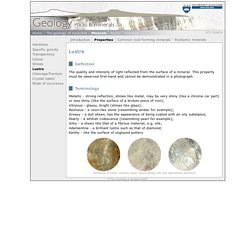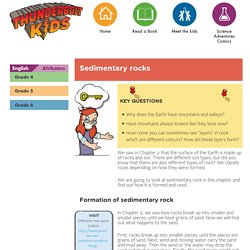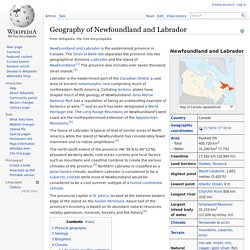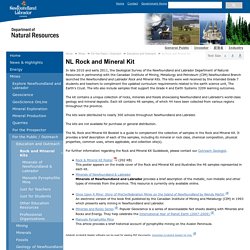

Geography: A Natural Setting Like No Other - Limestone Barrens of Newfoundland, Canada. Geological Survey. Mineral Gallery - Smithsonian Institution. Diamond - Mineral Gallery - Smithsonian Institution. Geology - rocks and minerals. Definition The quality and intensity of light reflected from the surface of a mineral.

This property must be observed first-hand and cannot be demonstrated in a photograph. Terminology Metallic - strong reflection, shines like metal, may be very shiny (like a chrome car part) or less shiny (like the surface of a broken piece of iron); Vitreous - glassy, bright (shines like glass); Resinous - a resin-like shine (resembling amber for example); Greasy - a dull sheen, has the appearance of being coated with an oily substance; Pearly - a whitish iridescence (resembling pearl for example); Silky - a sheen like that of a fibrous material, e.g. silk; Adamantine - a brilliant lustre such as that of diamond; Earthy - like the surface of unglazed pottery. Thunderbolt Kids. In Chapter 2, we saw how rocks break up into smaller and smaller pieces, until we have grains of sand.

Now we will find out what happens to the sand. First, rocks break up into smaller pieces, until the pieces are grains of sand. Next, wind and moving water carry the sand and mud away. Then the wind or the water may drop the sand and mud in one place. Finally, the sand grains might get stuck together again over time and make new rock. Sediments When the sand grains collect on top of each other, they form a sediment. Let's have a look at how sediments are deposited over time. Alarge see-through jar (you can make this from a 2-litre cold-drink bottle) different places for groups to collect sand and soil. Rocks and Minerals - Planet Earth. OneGeology - eXtra - OneGeology Kids - Rocks and minerals. Hi, my name is Larry and I want to tell you everything I know about rocks and minerals.

Rocks are made up of different types of minerals — a bit like the ingredients in a cake! Floor tiles can be made from slate, sandstone and marble. Metals such as copper and lead are used a lot in buildings, mostly in pipes for water and gas. Homes can be built out of lots of different things – different types of rocks such as sandstone or granite or bricks made from clay. Cement used to hold bricks together is made using limestone, clay, shale and gypsum. Aggregates are used to make roads and concrete.
Water is pumped up from underground stores of water in rocks – these are called aquifers. Weathering and erosion. Mechanical weathering physically breaks up rock.

One example is called frost action or frost shattering. Water gets into cracks and joints in bedrock. When the water freezes it expands and the cracks are opened a little wider. Over time pieces of rock can split off a rock face and big boulders are broken into smaller rocks and gravel. This process can also break up bricks on buildings. Streak (mineralogy) The streak (also called "powder color") of a mineral is the color of the powder produced when it is dragged across an unweathered surface.

Unlike the apparent color of a mineral, which for most minerals can vary considerably, the trail of finely ground powder generally has a more consistent characteristic color, and is thus an important diagnostic tool in mineral identification. If no streak seems to be made, the mineral's streak is said to be white or colorless. Streak is particularly important as a diagnostic for opaque and colored materials. It is less useful for silicate minerals, most of which have a white streak or are too hard to powder easily. Aboriginal mining guide. Minerals in everyday lives. Expeditions to the Seafloor. Mining Matters.
Geography of Newfoundland and Labrador. Labrador is the easternmost part of the Canadian Shield, a vast area of ancient metamorphic rock comprising much of northeastern North America.

Colliding tectonic plates have shaped much of the geology of Newfoundland. Gros Morne National Park has a reputation of being an outstanding example of tectonics at work,[3] and as such has been designated a World Heritage Site. The Long Range Mountains on Newfoundland's west coast are the northeasternmost extension of the Appalachian Mountains.[1] The fauna of Labrador is typical of that of similar areas of North America while the island of Newfoundland has considerably fewer mammals and no native amphibians.[4] The provincial capital is St. Physical geography[edit] Labrador is an irregular shape: the western part of its border with Quebec is the drainage divide for the Labrador Peninsula. Geology[edit] Biosphere[edit] Many rare herbaceous plants and insects occur on the island.[20] The west coast of the island supports over 200 plant species. Natural Resources. Rock and Mineral Kit. In late 2010 and early 2011, the Geological Survey of the Newfoundland and Labrador Department of Natural Resources in partnership with the Canadian Institute of Mining, Metallurgy and Petroleum (CIM) Newfoundland Branch launched the Newfoundland and Labrador Rock and Mineral Kits.

The kits were well received by the intended Grade 7 students and teachers to compliment the updated curriculum requirements related to the earth science unit, The Earth's Crust. The kits also include samples that support the Grade 4 and Earth Systems 3209 learning outcomes. The kit contains a unique collection of rocks, minerals and fossils showcasing Newfoundland and Labrador's world-class geology and mineral deposits.
Each kit contains 46 samples, of which 44 have been collected from various regions throughout the province. The kits were distributed to nearly 300 schools throughout Newfoundland and Labrador. The kits are not available for purchase or general distribution. Minerals of Newfoundland and Labrador.